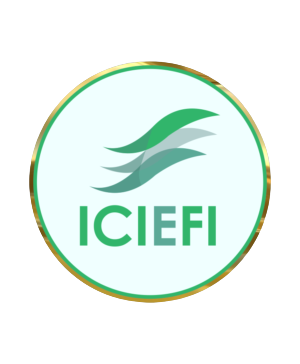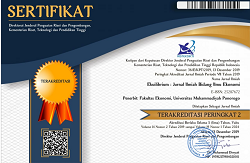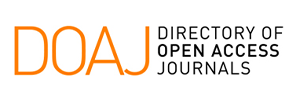Analysis of Information System Success in the Colleges in East Java with Wijayanto’s Approach of Information System Success Model
DOI: 10.24269/ekuilibrium.v15i1.2020.pp70-82
Abstract
The era of globalization, which is marked by reforms in the field of information, requires good top management support and can support the application of information systems for the creation of quality, useful, and competitive information. Information systems in colleges are tools for managers to complete both new roles and traditional roles, enabling managers to monitor, plan, and predict more precisely and quickly to respond quickly to changes in the business environment. The purpose of this study is to analyze the role of top management support as a moderating variable effect of product quality on use and analyze the role of organizational culture as a moderating variable the effect of the use on benefits. The population of this study was colleges in East Java, a sample of 164 colleges consisting of 57 colleges ranked in Webometrics, and 107 colleges ranked in Webometrics. The analysis came with the SEM-Amos 22 program. The results showed that top management support moderated the effect of product quality on pure use of moderation, and organization culture moderated the effect of the use on benefits in a quasi-moderation manner.
Keywords
Information systems college, Top management support, Organization culture
References
- Ahuja, M. K., J. B. Thatcher, 2005, “Moving Beyond Intentions and Toward the Theory of Trying: Effects of Work Environment and Gender on Post-Adoption Information Technology Use”, MIS Quarterly, vol. 29, no 3, pp. 427-460.
- BAN-Perguruan Tinggi, 2011, Kumpulan instrument standart 11 sisteminformasi Perguruan Tinggi, Departemen Pendidikan Nasional.
- Beaudry, A., Pinsonneault A., 2005, “Understanding User Responses to Information Technology: A Coping Model of User Behavior”,MIS Quarterly, vol. 29, no. 3, pp. 493-525.
- Boynton, Wiliam C., Johnson, Raymond N & Walter G. Kell., 2001, Modern Auditing7th Edition, John Wiley & Sons, Inc, New York
- Brown, S., Venkatesh V, 2005, “Model of adoption technology in households: a baseline model test extension incorporating household life cycle”, MIS Quarterly, vol. 27, no. 3, pp. 479-501.
- Brynjolfsson, 2006, “What Manager Should Know About ERP/ERP II”, Management Research New, vol. 29, no. 4, pp. 184-193.
- Cameron and Quinn, 1999, Diagnosing and changing organizational culture: Based on the competing value framework reading, Massachusetts, Addison-Wesley publishing company, inc.
- Carr, A.S., Smeltzer, L.R., 1997, “An Empirically Based Operational Definition of Strategic Purchasing“, European Journal of Purchasing and Supply Management, vol. 3, no. 4, pp. 199-207.
- Chen, I.J., Paulraj, A., 2004, “Towards of Theory of Supply Chain Management: the Construct and Measurement”, Journal of Operations Management, vol. 22, pp. 119-150.
- Chien, S.W., Tsaur, S.M., 2007, “Investigating The Success of ERP System: Case Studies in Three Taiwanese High Tech Industries”, Computer in Industry, vol. 58, no. 11, pp. 783-793.
- Curry J., R., 2002, Web Portals and Higher Education, Jossey-Bass, A Willey Company.
- Curtis B., Hefley B., Miller S., 2009, People Capability Maturity Model (P-CMM) version 2.0, Second Edition, Software Engineering Process Management. Carnegie Mellon University.
- DeLone, McLean, 2003, ”The DeLone and McLean model of information system success: a ten-year updated”, Journal of the management information system, vol. 19, no. 4, pp. 9-30.
- Djokopranoto R., dan Indrajid R., E., 2010, Manajemen Perguruan Tinggi Modern, Sekolah Tinggi Manajemen Informatika dan Komputer Perbanas, dan Yayasan Atma Jaya, Jakarta.
- Hameed S., Javaid Butt, and Tariq, M., J., 2012, ”The factors causing failure of foreign enterprise resource planning (ERP) systems in Pakistan”, African Journal of Business Management, vol. 6, no. 3, pp. 946-955.
- Holland, D. and Kumar, S. (1995), “Getting Past the Obstacles to Successful Reengineering'', Business Horizons, May/June, pp. 79-85
- Ifinedo, P., 2007, “Extending the Gable dkk. Enterprise Systems Success measurement model: a preliminary study”, Journal of Information Technology Management, vol.17, no. 1, pp.14-33.
- Indrajid R., E., 2011, Peranan Teknologi Informasi pada Perguruan Tinggi-Paradigma-Konsep-Strategi Implementasi, APTIKOM.
- Krause, D.R., 1999, “The Antecedents of Buying Firm’s Efforts to Improve Suppliers”, Journal of Operations Management, vol. 17, no. 2, pp. 205– 224.
- Lapointe, L., S. Rivard, 2005, “A Multilevel Model of Resistance to Information Technology Implementation”,MIS Quarterly, vol. 29, no 3, pp. 461-492.
- O’Brien, James A., 2006, Introduction to Information System, 12th Edition, McGraw Hill Companies Inc, New York.
- Parasuraman, 1998, “A Multiple-Item Scale for Measuring Consumer Perception of Service Quality”, Journal of retailing, vol. 64, no. 1, pp. 12-40.
- Ragu Nathan, M. Tarafdar, Bhanu S., R-N, 2008, “The Consequences of Technostress for End Users in Organizations: Conceptual Development and Empirical Validation”, Information Systems Research, vol. 19, no. 4, pp. 417–433
- Tarigan Zeplin, 2009, “Pengaruh implementasi ERP pada Product Differentiation dan cost Leadership dalam meningkatkan Kinerja Perusahaan”, Jurnal Manajemen Pemasaran, vol. 4, no. 1, pp. 11-15.
- Trisda Dewi S.A., and Dwirandra A., 2013, “Pengaruh dukungan manajemen puncak, kualitas sistem, kualitas informasi, pengguna aktual dan kepuasan pengguna pada implementasi sistem informasi keuangan daerah di kota Denpasar”, E-Jurnal Akuntansi Universitas Udayana, vol. 4, no. 1, pp. 196-214.
- Undang-UndangRepublik Indonesia nomor 12 tahun 2012, tentangPendidikan Tinggi.
- Van Lommel, E., and DeBander, B., 1975, “The Organization of EDP Activities and Computer Use”, Journal of Bussiness.
- Wei, K. S., Loong, A. C., Leong, Y. M., &Ooi, K. B., 2009, “Measuring ERP system success: a respecification of the Delone and McLean’s IS success model”, Paper presented at the Symposium on Progress in Information and Communication Technology (SPICT’0), Kuala Lumpur, Malaysia.
- Wijayanto, 2018, Model kesuksesan system informasi, Retrieved from http://oipas.sentraki.umpo.ac.id/model-kesuksesan-sistem-informasi-1.
Refbacks
- There are currently no refbacks.

This work is licensed under a Creative Commons Attribution-ShareAlike 4.0 International License.















